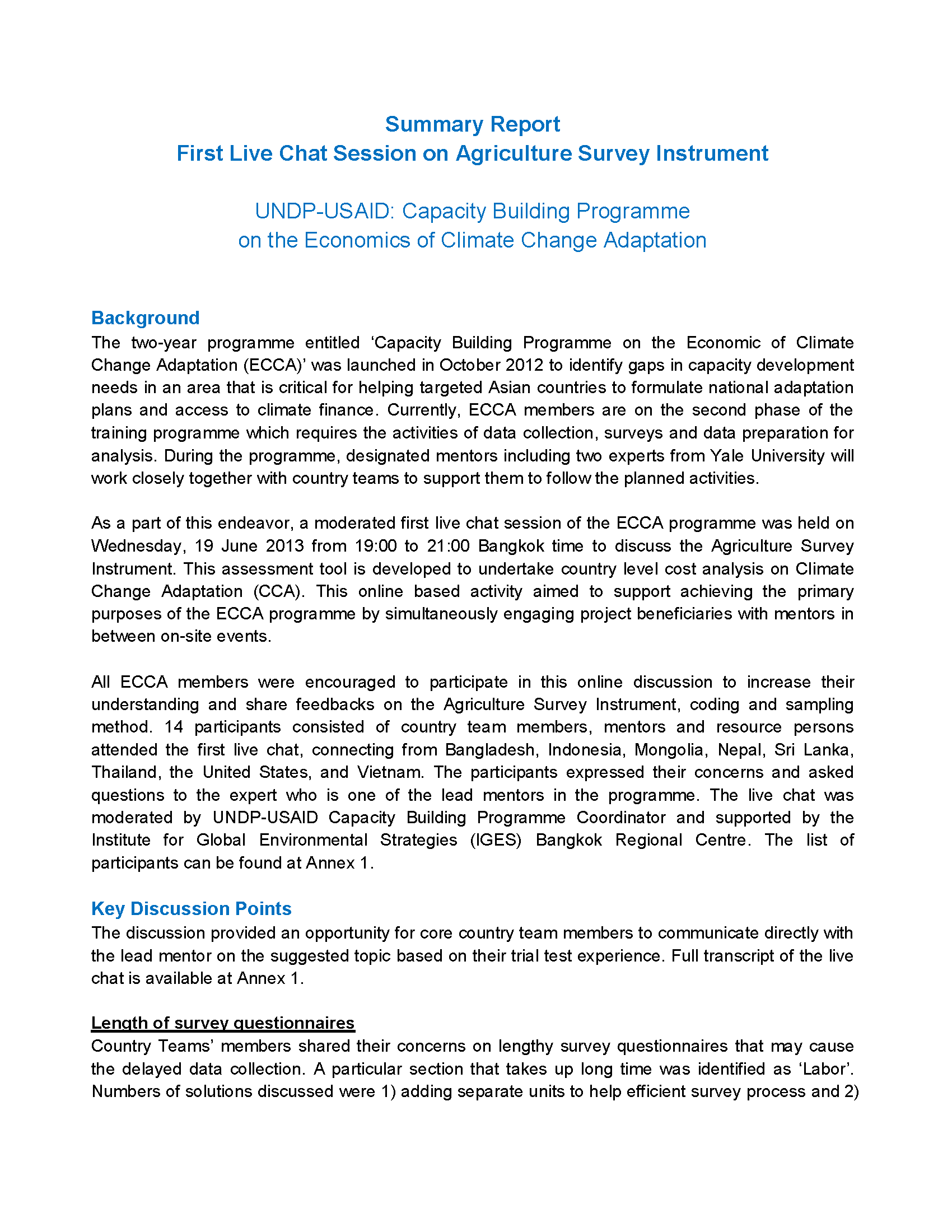Summary Report: First Live Chat Session on Agriculture Survey Instrument

Summary
The two-year programme entitled ‘Capacity Building Programme on the Economic of Climate Change Adaptation (ECCA)’ a cooperative effort between UNDP, USAID Adapt Asia-Pacific, the Asian Development Bank (ADB) and Yale University, was launched in October 2012 to identify gaps in capacity development needs in an area that is critical for helping targeted Asian countries to formulate national adaptation plans and access to climate finance. During the programme, designated mentors including two experts from Yale University worked closely together with country teams to support them to follow the planned activities.
As a part of this endeavor, a moderated first live chat session of the ECCA programme was held on Wednesday, 19 June 2013 from 19:00 to 21:00 Bangkok time to discuss the Agriculture Survey Instrument. This assessment tool is developed to undertake country level cost analysis on Climate Change Adaptation (CCA). This online based activity aimed to support achieving the primary purposes of the ECCA programme by simultaneously engaging project beneficiaries with mentors in between on-site events. It followed and built upon the first regional ECCA capacity building workshop held in March 2013.
All ECCA members were encouraged to participate in this online discussion to increase their understanding and share feedbacks on the Agriculture Survey Instrument, coding and sampling method. This ‘live’ discussion was attended virtually by 11 participants across three time zones from Bangladesh, Indonesia, Mongolia, Nepal, Thailand, Vietnam, and Yale University.
This summary document (download from the right-hand column) records the lively discussion that followed, including key discussion points (provided below), major concerns and next steps.
A second live discussion took place on 10 September 2013 from 19:00 to 21:00 (Bangkok time) to discuss the structure and content, ECCA Country Team expectations, and the preparatory work and materials for the second regional ECCA capacity building workshop held in late September 2013.
Key Discussion Points
Length of survey questionnaires
Country Teams’ members shared their concerns on lengthy survey questionnaires that may cause the delayed data collection. A particular section that takes up long time was identified as ‘Labor’. Numbers of solutions discussed were 1) adding separate units to help efficient survey process and 2) different categorization of labor activities. The preferred solution at this stage is to shorten the labor section altogether and cut survey time. It was also recommended by the expert to select a comfortable unit for respondents and then convert it to the original survey unit. It was agreed that the survey questionnaires should be shortened. The lead mentor will get back to country teams for further clarification on this matter.
Selection criteria of plots and crops
It was again emphasized that the plot 1 should be the prime parcel of land that the farmer considers it as the main agricultural land. The plot 2 should be the combination of all other farming lands of the respondent. The survey allows up to 4 crops per plot per season (these should be the 4 crops that occupy the largest portion of a plot’s area). The sample crops should be selected in terms of value and area of cultivation.
Numbers of survey sampling
It was clearly mentioned that the survey aims for at least 300 samples for the main survey and around 5-10 for the pre-test. One of the main concerns raised was that the suggested size of sampling may be too small to serve its purpose. However, it was discussed that increasing the numbers survey will bring the cost escalation. The lead mentor will get back to country teams for further clarification on this matter if there are any lingering concerns, though the current sampling target is adequate as long as there is sufficient variation in agro-climatic zones.
Scope of survey sampling
Having diversity in agro-ecological zones (AEZ’s) in the process of sampling is important to gauge the impact of Climate Change. However, in reality, limited resources may allow countries to focus on fewer AEZs. Maximizing the variation in AEZs is very much a preferred objective for country teams.
Question code modification
Some countries made changes on particular sections of the survey questionnaires to accommodate country specific survey environment. In this regard, members were requested to inform the lead mentor on any modification made. Additional questions are allowed by adding a code based on the original coding structure provided.
Subsidized agricultural commodities
It was reminded that the issue of government subsidized agricultural commodities and its relation to farmers’ decision in crop planting is covered at section 4.6.1. It was also mentioned that a question asking the amount of subsidy received may be added.
Definition of Subsistence and Commercial Crops
This is an issue that has repeatedly come up in discussions outside of the live-chat. We will drop the distinction from the survey. The live-chat discussion suggested that the terms can be reasonably defined by each country. As a general rule, farms that grow crops for commercial sale are commercial farms, while farms that grow for household needs are subsistence farms. However, it was noted that the scope of this term is still blurry. Therefore, it was felt that dropping the question altogether would simplify things.
Ownership of farm machinery
It was noted that the both cases of rented and owned machinery were not reflected enough in the survey questionnaires. Including a question asking the quantity and the price of rented machinery was suggested.
Funded through USAID’s Regional Development Mission for Asia (USAID/RDMA) and implemented by AECOM, USAID Adapt Asia-Pacific was designed to share information and best practices about climate change adaptation finance modalities and project preparation tools and help governments build capacity to access the existing pool of international climate change adaptation funds.
(0) Comments
There is no content